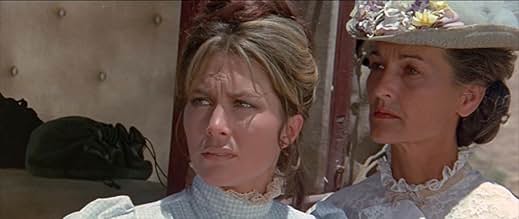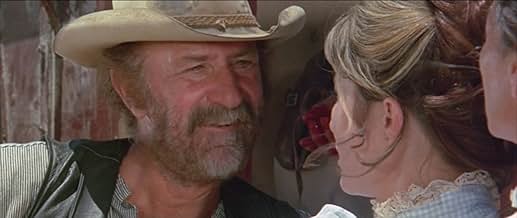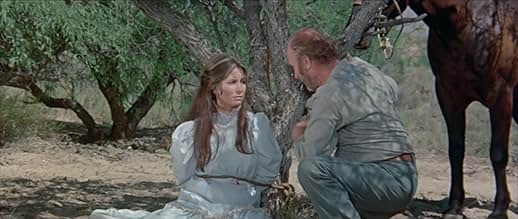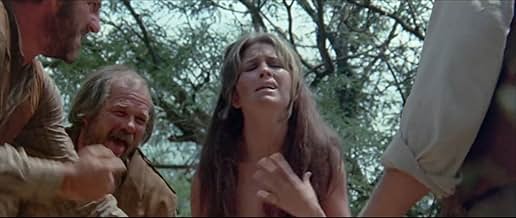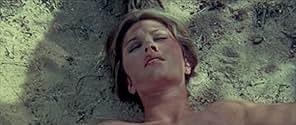अपनी भाषा में प्लॉट जोड़ेंA woman tracks down the five men who raped her, helped by an Apache.A woman tracks down the five men who raped her, helped by an Apache.A woman tracks down the five men who raped her, helped by an Apache.
Joe Turkel
- Peyote
- (as Joseph Turkel)
William Bryant
- Sheriff Martin Lord
- (as Bill Bryant)
Steve 'Bunker' de France
- Tucson Deputy
- (as Steve Michel De France)
फ़ीचर्ड समीक्षाएं
The sort of movie where the Native American outfits appear to have come from Woolworth complete with rawhide leather go-go boots. The multiple titles alone tip you off it was hastily made for the bottom half of drive-in bills. It's sort of interesting in how it reflects (or panders to) the spirit of the late 60's/early 70's: protofeminist condemnation of rape, and peacenik condemnation of revenge. Meanwhile the viewers are supposed to get their kicks from the aforementioned acts, though at least the rape happens off-screen. Also typical of movies at the time, the story is bleak and pessimistic but for once mercifully short. Still it's worthy as a vehicle for Keenan Wynn, known for playing endearing cantankerous roles like Alonzo P. Hawk in the Disney Flubber movies. Here he has a scenery-chewing good time as a genuinely nasty bad guy, and he looks radiantly fit in his S & M-tinged nude scene. Another bonus is the theme music by future pina colada songwriter & Broadway director Rupert Holmes.
...this might have been a decent western. The story, of a school teacher captured, raped and left for dead by thugs, whose then saved by a lone Apache she forms a bond with is nothing new. And neither is this rather dull movie. The ending is entirely predictable (again, in the hands of a more imaginative director, perhaps this would have been avoided). The saving grace is the beautiful Michele Carey, who actually shows some skin and Henry Silva as the Apache, Chatto. Keenan Wynn is surprisingly good as the lead villain, but the set ups are almost bad enough to be TV westerns and again, the story fails in the end.
A revenge tale set in the West.
It would be a ridiculously horrible movie on its own. Keenan Wynn and the other four "savage men" are just the same annoying Hollywood stereotypes we see in most movies, laughing while they kill. For some reason, they even kill a pretty woman when they claim they want women for other reasons, so don't look for "motivation" in this movie.
For whatever reason, they don't kill the other pretty women, but rape her. Of course she goes for revenge with the help of Henry Silva, and since this is the seventies, Silva has to be a Native American in order to be anything but a slob.
What saves this movie, somewhat, is the comic relief from a posse led by John Anderson, who is always a step behind the heroic pair. The rest is pretty much fast forward formula.
It would be a ridiculously horrible movie on its own. Keenan Wynn and the other four "savage men" are just the same annoying Hollywood stereotypes we see in most movies, laughing while they kill. For some reason, they even kill a pretty woman when they claim they want women for other reasons, so don't look for "motivation" in this movie.
For whatever reason, they don't kill the other pretty women, but rape her. Of course she goes for revenge with the help of Henry Silva, and since this is the seventies, Silva has to be a Native American in order to be anything but a slob.
What saves this movie, somewhat, is the comic relief from a posse led by John Anderson, who is always a step behind the heroic pair. The rest is pretty much fast forward formula.
This would-be "with-it" revenge story in Western garb is notable only for having a female protagonist thus anticipating the cult item HANNIE CAULDER (1971). Still, Michele Carey's terrible central performance and her squeaky voice basically sink the film entirely as she projects little emotional scars from her ordeal; in fact, she seems to get back into a happy mood way too soon after her rape! The sadistic cast of characters are led by notorious bandit Keenan Wynn and Henry Silva is surprisingly cast as the Apache good guy who helps Carey carry out her retribution (interestingly, he had previously appeared in a similar - and much superior - tale, THE BRAVADOS [1958]). Another nail in the film's coffin is the sheer poverty of the direction which generates no suspense whatsoever as Silva and Carey are merely seen to effortlessly stumble upon each of the rapists' new hideout, kill them off without much ado and exit the scene; add to that the puerile fast-cutting technique employed intermittently which grows tiresome before too long. The trebly ironic ending, then, is a valiant attempt at resurrecting the movie but by then it is too late and only a fairly decent score saves the whole thing from a BOMB rating.
A young lady is manhandled after a stagecoach robbery in Arizona and left for dead (Carey), but a solitary Apache patiently sees to her restoration (Silva). They eventually team-up to pursue justice. John Anderson plays the righteous lawman that heads the posse while Keenan Wynn is on hand as the leader of the thug scum.
"The Animals" (1970), also known as "Five Savage Men," is an obscure 'B' Western that was the blueprint for "Hannie Caulder" (1971) and "I Spit on Your Grave" (1978). Michele was 27 during shooting and one of the most beautiful women on earth at the time. You might remember her from "El Dorado" (1966), "Live a Little, Love a Little" (1968) and "Dirty Dingus Magee" (1970).
The score was written by Rupert Holmes, known for his hit "Escape (The Pina Colada Song)." It starts out dubious because it's mod-ish and seemingly unfitting for a movie that takes place in the Old West, but other Westerns had already set this precedent in the 60s. Thankfully, the music improves with some parts featuring notable percussive pieces and others that are moving.
Most of the reviews are pretty low, but I'm sure this is due to the lousy first impression of the score and other technical deficiencies of what is likely the only print available. Sure, it's low budget and reminiscent in tone of the contemporaneous "Cry Blood, Apache," but it's superior to that barbaric and dismal revenge yarn.
For instance, it's more than just a brutal crime/revenge flick as the center of the story focuses on a noble 'savage' who contrasts the five Caucasian savages from the first act. He develops a successful cross-cultural relationship with the white woman back when it was socially unacceptable on either side. For anyone who argues that this is unrealistic, Apache men back then were people just like you and me today. They weren't all cookie-cutter. One or two here and there were more individualistic compared to the typical brave and could even be viewed as outcasts. That seems to be the case here.
The last act switches to the expected vengeance à la "Hang 'Em High" (1968), but the climax is surprising, offering a lesson on how even a noble individual can grossly misjudge another person (or people) & situation, and actually commit a crime. That's why the bible advises not judging until enough accurate info is acquired to make a just assessment; and, even then, you have to be careful.
There are unexpected creative bits as well, like the well-done Apache stare-down sequence and the fistfight over the saloon lass in the street.
I also disagree that "The Animals" can be written off as a rip-off of Spaghetti Westerns. It's an American production shot completely in Arizona and I could cite numerous American Westerns as influential. Don't think for a second that Sergio Leone's "Man With No Name" trilogy was wholly original. For instance, Ennio Morricone's score for "A Fistful of Dollars" features a moving piece glaringly inspired by Dimitri Tiomkin's outstanding "El Degüello" from "Rio Bravo" (1959).
Lastly, unlike the typical Italian Western caricatures, this flick provides actual characters. The core relationship is actually touching and so the flick scores well in the human interest department.
The film runs 1 hour, 26 minutes, and was shot in Arizona, e.g. Saguaro National Park, Old Tucson, Sonoran Desert, Sierrita Mountains and Santa Cruz River.
GRADE: B.
"The Animals" (1970), also known as "Five Savage Men," is an obscure 'B' Western that was the blueprint for "Hannie Caulder" (1971) and "I Spit on Your Grave" (1978). Michele was 27 during shooting and one of the most beautiful women on earth at the time. You might remember her from "El Dorado" (1966), "Live a Little, Love a Little" (1968) and "Dirty Dingus Magee" (1970).
The score was written by Rupert Holmes, known for his hit "Escape (The Pina Colada Song)." It starts out dubious because it's mod-ish and seemingly unfitting for a movie that takes place in the Old West, but other Westerns had already set this precedent in the 60s. Thankfully, the music improves with some parts featuring notable percussive pieces and others that are moving.
Most of the reviews are pretty low, but I'm sure this is due to the lousy first impression of the score and other technical deficiencies of what is likely the only print available. Sure, it's low budget and reminiscent in tone of the contemporaneous "Cry Blood, Apache," but it's superior to that barbaric and dismal revenge yarn.
For instance, it's more than just a brutal crime/revenge flick as the center of the story focuses on a noble 'savage' who contrasts the five Caucasian savages from the first act. He develops a successful cross-cultural relationship with the white woman back when it was socially unacceptable on either side. For anyone who argues that this is unrealistic, Apache men back then were people just like you and me today. They weren't all cookie-cutter. One or two here and there were more individualistic compared to the typical brave and could even be viewed as outcasts. That seems to be the case here.
The last act switches to the expected vengeance à la "Hang 'Em High" (1968), but the climax is surprising, offering a lesson on how even a noble individual can grossly misjudge another person (or people) & situation, and actually commit a crime. That's why the bible advises not judging until enough accurate info is acquired to make a just assessment; and, even then, you have to be careful.
There are unexpected creative bits as well, like the well-done Apache stare-down sequence and the fistfight over the saloon lass in the street.
I also disagree that "The Animals" can be written off as a rip-off of Spaghetti Westerns. It's an American production shot completely in Arizona and I could cite numerous American Westerns as influential. Don't think for a second that Sergio Leone's "Man With No Name" trilogy was wholly original. For instance, Ennio Morricone's score for "A Fistful of Dollars" features a moving piece glaringly inspired by Dimitri Tiomkin's outstanding "El Degüello" from "Rio Bravo" (1959).
Lastly, unlike the typical Italian Western caricatures, this flick provides actual characters. The core relationship is actually touching and so the flick scores well in the human interest department.
The film runs 1 hour, 26 minutes, and was shot in Arizona, e.g. Saguaro National Park, Old Tucson, Sonoran Desert, Sierrita Mountains and Santa Cruz River.
GRADE: B.
क्या आपको पता है
- ट्रिवियाOnly career nude scene for Michele Carey.
- भाव
Posseman #1: Allan! Allan! Pieces of a woman's dress... stakes...
Sheriff Allan Pierce: Stripped her down... Stripped her down and tied her up... sons of bitches!
- कनेक्शनFeatured in 42nd Street Forever! Volume 1: Horror on 42nd Street (2004)
टॉप पसंद
रेटिंग देने के लिए साइन-इन करें और वैयक्तिकृत सुझावों के लिए वॉचलिस्ट करें
- How long is The Animals?Alexa द्वारा संचालित
विवरण
- चलने की अवधि1 घंटा 26 मिनट
- ध्वनि मिश्रण
- पक्ष अनुपात
- 2.35 : 1
इस पेज में योगदान दें
किसी बदलाव का सुझाव दें या अनुपलब्ध कॉन्टेंट जोड़ें

